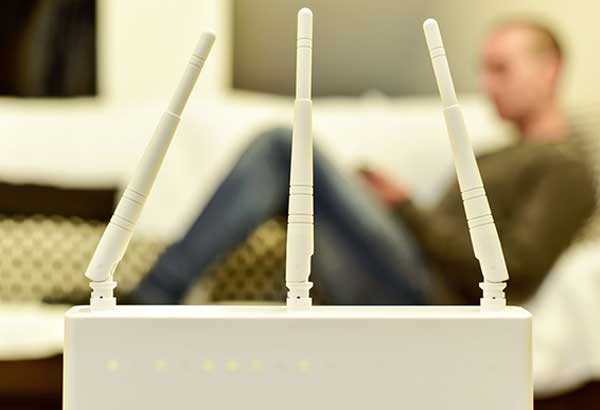Help, I hit a dead spot

Just say no to dead spots: Wi-Fi connections are made better if routers are put in proper places.
I recently set up my Wi-Fi connection in my house. Not really an expert on setting up my Wi-Fi router, I did my best as I read up on what had to be done to get the best connection — and, finally my Wi-Fi was up and running. Or so I thought.
Since I am the main user of the Wi-Fi at home, I asked my Wi-Fi provider to set up the router and Wi-Fi connection in my room — knowing that most of my Wi-Fi use would be when I am home at night.
But just last weekend, I had more time at home and opted to see just how good the connections were from other parts of the house.
As luck, would have it, good or bad, who knows? I hit a dead spot as I walked around the house while connected to the Wi-Fi.
I did some research online and found out that a dead spot (also sometimes called a dead zone), is an area within your house wherein the Wi-Fi does not work. Yes, there were places at home where my Wi-Fi seemed to have lost its connection to the router in my rooms.
I was kind of pissed when I hit the dead spot because I was in the middle of downloading an all-important pet training video. Yes, this Wi-Fi dead spot sort of killed my productivity and ruined the downloading experience.
WHAT CAUSES WIFI DEAD SPOTS?
I went back to the better Wi-Fi connection spot at home and did more research about the causes of dead spots.
For starters, I learned that the Wi-Fi connection works by transmitting radio waves that can be picked up by any device with the right reliever technology. If these waves are interrupted, obstructed or altered, the result is poor network performance or a completely dead spot.
Of course, there is also that all-important signal strength. I was aware that the farther away I am from the router, the weaker the signal. And then there are the walls, doors and large metal objects like filing cabinets that reduce signal strength by up to 50 percent.
What I did not know is that appliances like stoves and fridges cause greater loss, up to 80 percent. There are other devices at home that produce signal interference — like microwave ovens, wireless security and sound systems, baby monitors — and hamper the connection, thereby causing a dead spot.
Also, since our home was built way back — it does have thick walls and with metal wiring, and sadly, these also interfere with Wi-Fi signal.
And, I also read that for those who live in condos, Wi-Fi signals are affected by dense wireless networks (e.g. you live in a building where every unit has a wireless router) configured on the same wireless channel, the signal strength will be affected, possibly producing dead zones.
No, the solution is not to leave your home. You just need to find a way to amplify your Wi-Fi connection. There are a few ways that the problem areas can be fixed. Let me share a few of them
Warning: I am not an expert.
How can you fix dead spots?
Back on the Internet, I did more research, which helped me discover that all good problem-solving begins with assessing the problem areas. In my case, it was trying to get a good signal in the garage and the kitchen.
There is such a thing as the WiFi Analyzer application (available on Google Play Store). This oh-so-helpful app helped me find out what the strength of my network was and the frequency of the surrounding networks. With the app installed on my smartphone, I walked around my house and observed which areas were most prone to signal fluctuation.
Let me share with you a few steps that helped me — and that could help you, too.
For starters, I repositioned my router. I moved it to a more central spot at home, but still kept it close to my room. However, if you live in a bigger household with more users — it might be better to put the router in a central spot — this way everyone who uses the Wi-Fi gets a good signal.
Next, remember that when checking out routers, it might be best to get one that is best for the number of users at home. So, an upgrade of your router might be in order. Check to ensure that your firmware or driver software is updated to get better chances of strong and consistent signal.
Third, adjust the router’s antenna. The antenna should be up and pointing vertically. Otherwise, the coverage might not be as strong.
Fourth, remove or reposition obstructions (at least the obstructions that are movable). Try rearranging your place to maximize signal strength from your wireless connection.
Fifth, consider other wireless channels. If possible, you might be better off connecting to a less crowded channel.
Sixth, set up a wireless repeater. A wireless repeater can extend your Wi-Fi coverage to a larger area. This is ideal especially if you have a large or multi-level house.
Seventh, consult your service provider. It always helps to call your service provider if they can offer customized and expert technical support to help you maximize your Wi-Fi connection.
Today, my Wi-Fi is up and running. I am able to get a good connection from almost every spot at home. But there are still days when I hit a dead spot and my connection falters. I understand that dead spots are inevitable, to a certain extent, but I am still hoping for a solution that will not require me to resort to DIY fixes. As we can all agree on, good Wi-Fi connections can be a real life-saver.



















